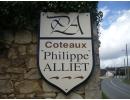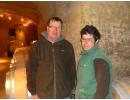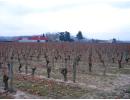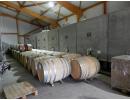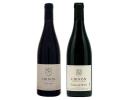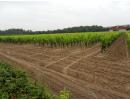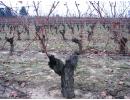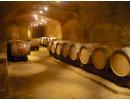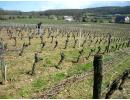Domaine Philippe Alliet
Philippe Alliet “Vieilles Vignes” - Chinon
The wine is produced from old Cabernet Franc vines of 40 to 60 years old representing 3.50 ha located in the plain at Cravant les Côteaux. The yield is 35 hl/ha on average similar to Grand Cru wines in other regions. The soil is sandy-gravelly from alluvial deposits. For the winemaking, the grapes are destemmed and the fermentations last about 3 weeks at 27°C in concrete vats. The ageing will last for 12 months in the same vats.
PVins notes: The colour is a little darker than the average Chinon, on the palate the tannins are elegant, it is well balanced by the acidity, aromatically it has some black fruit characteristics with an earthy overtone presumably from the type of soil. The wine may be cellared for up to 10 years depending on the vintage.
Pilippe Alliet “Côteau de Noiré” - Chinon
This the Domaine's premium wine from Cabernet Franc, considered to be by the French critics the best that the appellation Chinon can offer. The parcel of 3 ha produces a yield of 35 hl/ha on average, which is similar to a Grand Cru in other regions. The grapes are destemmed and the fermentations last about 4 weeks in concrete vats at 27°C. The wine is barrel aged for 14 months in 500 litres demi-muid oak barrels of which 40% are new and 60% are 1 and 2 years old, then a further 4 months in concrete vats for the wine to settle. The barrels are transfered to a limestone cellar at the lieu-dit "Noiré" for the duration of the ageing.
PVins notes: The result is a clean and pure expression of Cabernet Franc. Dark cherry red in colour, beautifully balanced, good depth and concentration, delicious ripe juicy fruit with hints of oak in its youth and a lively freshness on the long finish. The wine can be cellared for a couple of decades in excellent vintages and its evolution will be similar to a Grand Cru from Philippe’s beloved Bordeaux.
The heart of Domaine Philippe Alliet is located on the commune of Cravant Les Côteaux east of Chinon. Philippe and his wife Claude manage the estate since 1985 after reuniting the parcels of vines that had been previously divided by his maternal grandfather on his retirement. Since 2011, their son Pierre is also involved in the work on the 17 ha estate. Philippe Alliet was part of a new generation of winemakers dedicated to low yields, optimum fruit ripeness and fastidious vineyard management. Inspired by the greatest wines of Bordeaux, Philippe aims to create wines of similar structure and power. His passion takes him to Bordeaux every year visiting growth wines such as Château Margaux. In the beginning, when he decided to use oak barrels for the ageing of his wines, he would purchase second hand oak barrels from Château Margaux every year while on his trip to Bordeaux. He wanted quality but could not afford new barrels, but this changed over the years when he was able to purchase a small amount of new french oak barrels each year directly from coopers. Always striving to produce high quality wines from Cabernet Franc, a new cellar was built in 2005 to improve the winemaking and storage facilities at the lieu-dit "La Pinnetrie" situated on the plains east of Chinon.
Philippe and Claude Alliet started with 8 ha in the plains near the hamlet Briançon at the lieu-dit “La Pinnetrie”, located on the commune of Cravant les Côteaux. This is where the “Tradition” and “Vieilles Vignes” Chinon wines come from, here the terroir is of alluvial deposits where the old vines represent 3.50 ha. The “Vieilles Vignes” is the wine that helped Philippe built a reputation right from the beginning, but the jewel of the crown came in 1989, when an opportunity arose to purchase 3 ha from a prestigious lieu-dit “Noiré” on the commune of Chinon.
The "Côteau de Noiré" area is set on steep clayey-limestone slope facing south. Philippe replanted 2 ha between 1996 and 2000 and kept 1 ha as originally planted in 1979. In 2001 Philippe Alliet acquired another 2 ha at the lieu-dit “L'Huisserie”, here the terroir is clayey-siliceaoussoils with flintstones locally known as “Péruche”. The parcel is located near the Chinon-Cravant communal border and not far from the “Côteau de Noiré”. He replanted the parcel and the first vintage produced was 2004. In 2008, he replanted a 0.50 ha parcel of limestone with Chenin Blanc with the aim to produce a rare white Chinon, only yielding 2,000 bottles. Currently the estate represents a total of 17 ha.
Philippe Alliet produces 5 Chinons: 4 reds "Tradition", "Vieilles Vignes", "Huisserie", a premium "Côteau de Noiré" and a rare Chinon Blanc.
In the past the wines were produced in 3 separate cellars but since 2005 all the wines are produced at the same location “La Pennetrie” where a new cellar was built. With a bigger cellar Philippe was able to increase the number of vats for his plot by plot approach. Up until 2012 a combination of stainless steel vats and concrete vats were used for winemaking, but since 2012 mainly concrete vats are used. The use of oak barrels has also evolved over the years. Since 2008, he has changed his approach in the use of oak to reduce the toasted character of the wines to encourage the Cabernet Franc and the terroir to express even more their characteristics. Philippe now only uses 500 litres oak barrels instead of the traditional Bordeaux 225 litres and there is also less new oak in the ageing of the wine "Côteau de Noiré". Since the 2012 vintage, Philippe has even stopped using oak barrels for the cuvée "Vieilles Vignes" (old vines).
In the vineyard little if any green harvest is done and the grapes are handpicked at the harvest. The Cabernet Franc grapes are destemmed before the fermentations that will last about 3-4 weeks. The Chenin Blanc will go through pre-fermentation skin-macerations and the fermentations will take place in large oak barrels that will last several weeks or months depending on the cellar and must conditions. Depending on the wines they will be aged in oak barrels for 12 to 14 months with different amounts of new oak. As for the “Côteau de Noiré” wine, the barrels will be transferred to the “Noiré” site for ageing in an old underground limestone cellar that was built in the hillside, it provides ideal conditions with very little temperature and hygrometric variations. The wines are estate bottled without filtration.
Some critics might think that his premium wine “Côteau de Noiré” is not very typical of Chinon, but you cannot hold a grudge against Philippe for bringing out the quintessence of the Cabernet Franc from the terroir of “Noiré”. The wine can easily be mistaken for a Grand Cru Classé of Bordeaux in a blind tasting. Still, the famous French critics of “La Revue du Vin de France” and “Bettane & Desseauve” classify Philippe Alliet as the best red wine producer of the Loire Valley and consider his “Côteau de Noiré” to be a benchmark for the Cabernet Franc.
Links: AOP Chinon - Touraine map - Loire Valley map - www.vinsvaldeloire.fr
CHINON
The Chinon appellation located in the Touraine sub-region of the Loire Valley is located southwest of the city Tours, on the bank of the Vienne River about 10 kilometres from where it joins the Loire River. The appellation covers 18 communes and is about 2,400 hectares in size, it is based on the town of Chinon.
History
The town of Chinon is well known for its medieval castle which at times served as the residence of the kings of France and England. The town developed especially during the reign of Henry II Count of Anjou, crowned King of England in 1154. Chinon is also the birthplace of RABELAIS the great epicurean French writer.
Vineyard
The vineyards are planted facing south-southwest covering the relatively steep banks of the Vienne river as well as the less steep slopes running northward from the hills above Chinon to the Loire. The terroir consist almost entirely of erosional scree and gravel on top of rather hard Turonian limestones. The Cabernet Franc from the stony terraces tend to produce fruit driven, soft and light wines, while the wines from the steeper clayey-tuffeau limestone areas along the hills such as at “Cravant les Côteaux”, “Chinon” and “Panzoult” tend to produce wines that are more tannic and complex with mineral, gamey and violet aromas. The wines from the plains tend to be soft and easy drinking as the terroir is made of alluvial deposits such as gravel and sand from the Vienne River.
Chinon is very well known for its Cabernet Franc locally named “breton”, it covers 95% of the appellation but the regulation allows a blend of up to 10% with Cabernet Sauvignon. Both grape varieties are originally from Bordeaux. Also a very small quantity of rosé (10%) is produced from Cabernet and the white wine (2%) from Chenin Blanc. The red wines tend to develop a velvety depth of spice flavours as they age, the wines from good producers in excellent vintages can be full-bodied and well structured for ageing.
Climate
The climate is more oceanic to the west and continental to the east.



